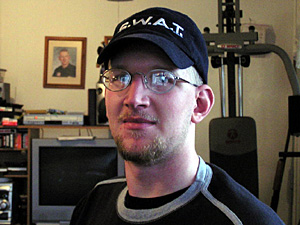Audio
Photos
Respond to this story
| |||||||||||||||||||||||||||||||||||
Minnesota soldier recovers after being injured in Iraq
December 29, 2004
 |
| Sgt. Jim Vandenheuvel spent about a year in Iraq with a National Guard Military Police unit based in southern California. He was injured February 11th, 2004 by a roadside bomb. (MPR Photo/Tim Post) |
Pierz, Minn. — Jim Vandenheuvel, 24, has returned to the home where he grew up. He's dressed in a sweatshirt and track pants, and a baseball cap hides scars on his head. A cane leans against his chair, and there's an orthopedic shoe on his left foot. The sole is several inches thick. It helps him walk on a leg that's eight centimeters shorter than it was before he left for war.
Growing up, Jim dreamed of becoming a State Patrol trooper. After graduating from Pierz Healy High School in 1999, he took law enforcement classes at a technical college.
Then came the perfect chance to build his resume. He joined a National Guard Military Police unit based in southern California. The unit was sent to Iraq in April 2003.
"I remember most of being in Iraq," Vandenheuvel says. "I don't remember the day of the attack or a couple of days before ... I don't want to remember anything that happened to me that day. If I remember, it'll keep me awake at night, I'm not going to be able to sleep and I'll cry my eyes out."
Sgt. Jim Vandenheuvel's job in Iraq was to help protect contractors working around Abu Ghraib prison. On Feb. 11, 2004, he was in a convoy of three Humvees on patrol outside the prison.
 | |||
"I was with my team leader and my driver. We're only six clicks away from the camp, only 6,000 meters," Vandenheuvel says.
Jim doesn't remember what happened next, but others have told him. He says they were heading out into the desert. His Humvee was in the middle of the pack, about 250 feet behind the lead vehicle.
"We drove over an IED, an improvised explosive device. It was one 55-millimeter shell, pretty damn big. We drove over the top of it, and it blew up. It blew the Humvee up into the air and kicked it off into the desert," Vandenheuvel says.
The blast instantly killed the driver. Another soldier, who survived, was blown out of the Humvee. Jim, still in the back, was in bad shape.
"They heard me moaning. They opened up the back door. My name was covered up, my face was all full with blood. There was no way of telling who I was, except they could tell by my blonde hair. They knew it was me because of my blonde hair," Vandenheuvel says.
Medics started work on Vandenheuvel immediately. He was losing lots of blood, he was burned, full of shrapnel, and had serious injuries to his head and legs. Jim was sent to a military hospital in Germany. And after a couple of months he was transferred to Walter Reed Medical center in Washington D.C.
 | |||
He doesn't remember anything from the time of the attack in February until sometime in the summer, when he was transferred to the Minneapolis VA hospital. After spending eight months in various hospitals, Jim came home this fall to the family farm near Pierz.
He's able to get around the house with the use of his cane. But the severity of his injuries is obvious when Jim lifts a pant leg. His right calf is gone, blown away by the blast. What's left of the muscle below the knee squirms under a thin layer of skin and scar tissue.
Most of the muscle from his left hip is gone too. His left leg is the one that was shortened, as muscle and bone were blown away.
Jim removes a baseball cap, revealing the injuries to his head. Scars peek out underneath his short, fuzzy blonde hair.
"I think most of my head is titanium plates," Vandenheuvel says.
It's the traumatic brain injury he suffered that will give Jim the most trouble. He says he's doing much better after a few months of speech therapy, and his memory is also improving. But he still struggles from time to time in conversation.
Jim Vandenheuvel is dealing with injuries that would have killed a soldier a few decades ago. That's due in part to better care for injured soldiers in the field.
 | |||
Dr. Barbara Sigford with the Minneapolis VA Hospital says when soldiers are hurt, they're quickly transferred to major medical centers. And after they've been patched up, they're given better rehabilitation.
"We certainly do have a lot of new technology available to us, and I think we're doing a better job of rehabilitation in terms of getting things done quickly," Sigford says.
Dr. Sigford says there's also been a change in how they deal with injured soldiers' long-range needs. She says those hurt in World War II, Korea or Vietnam, didn't get the attention they needed down the road.
"There may have been a very lengthy inpatient period of rehabilitation, and then essentially they were not followed for the long run," says Sigford. "Often times this made a significant impact on their life, and there was no one to turn to for help after they were discharged from their inpatient care."
Sigford is working to get injured soldiers the followup care they need, both physical and emotional. Her goal is to help soldiers return to their lives in the best shape possible.
"I have known enough people to come through very severe trauma, and still be able to lead a very meaningful life, and play a meaningful role in their families and in the community ... even though that might be a different from what it might have been," Sigford says.
Jim Vandenheuvel's goal right now is to get stronger. He works out every day on a weight machine in his family's living room. He still holds on to the ultimate goal of working as a cop, maybe a State Patrol trooper. His whole motivation behind signing up for the Guard was to get experience for that job.
"Now that I've been injured, it's a different story. I don't what a hiring board would say," Vandenheuvel says.
Jim doesn't get too worried about his future. He'll be able to do something, he says, even if it's not law enforcement. For now he's happy be back home.
|
News Headlines
|
Related Subjects
|

